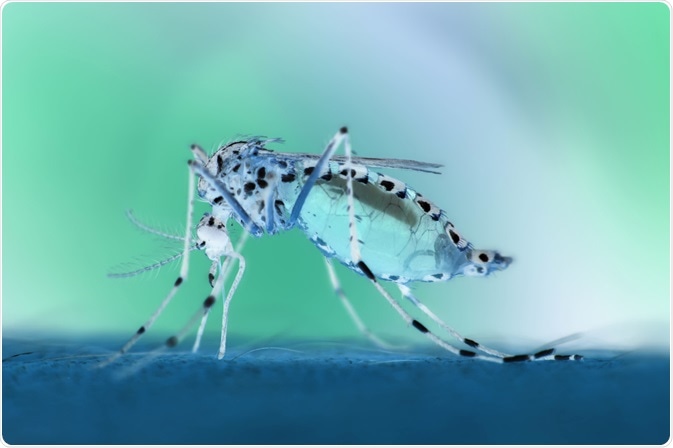During recent history, tropical regions of the world were more severely affected by infectious diseases in comparison to the temperate world. Principal reasons why infectious diseases can thrive in such regions can be found in both environmental and biological factors that support high levels of biodiversity of pathogens, vectors and hosts, but also in social factors that undermine efforts to control these diseases.
Such infectious diseases are known simply as tropical diseases (as they are disproportionately more prevalent than other non-infectious diseases), and tropical medicine has emerged as an important discipline for their study. The most important part of the research is figuring out the relationship between humans, a microorganism, and a vector that can move the pathogen between humans.
 Image Credit: NaibankFotos / Shutterstock.com
Image Credit: NaibankFotos / Shutterstock.com
Examples of tropical diseases
Tuberculosis represents the leading cause of death associated with infectious diseases globally, and its incidence is on the rise in tropical areas due to the interaction between tuberculosis and HIV epidemics. In many regions of the world this disease predominantly affects young adults, and increasing resistance of the pathogen to antimicrobial drugs is a worrisome sign.
Malaria is an infectious, hematologic disease caused by parasitic protozoa from a large genus Plasmodium. More than one million Africans die from malaria each year, most of them children under 5 years of age. This disease alone is estimated to be responsible for approximately 1.3% of the annual reduction in economic growth for countries with the highest burden of this disease.
Diarrhea remains one of the most common diseases that also affects children under 5 years of age, leading to considerable mortality in childhood. Rotavirus remains the most common cause of severe diarrheal illness, albeit a myriad of countries (such as Bangladesh, Somalia, Rwanda, Zaire and Nepal) have seen serious epidemics due to the multiple resistant bacterium Shigella dysenteriae that causes dysentery.
Leishmaniasis is a group of diseases caused by parasites of the genus Leishmania, which is endemic in 88 countries and leads to significant morbidity and mortality. This infectious disease is spread by the bite of Phlebotominae sand flies, and the disease can affect the skin (cutaneous leishmaniasis) and internal organs (visceral leishmaniasis).
Strongyloidiasis a common cause of disease in tropical and subtropical areas, as a warm climate is suitable for parasite survival. The clinical presentation varies with the status of the host’s immune system, and the infection can be classified as acute, chronic and severe. In immunosuppressed patients uncontrolled autoinfection with Strongyloides parasite can ensue, leading to hyperinfection syndrome.
African trypanosomiasis, also commonly known as African sleeping sickness, is a neglected parasitic disease spread by the tsetse fly. It is caused by a protozoan Trypanosoma brucei, and since the 1970s this infectious disease has re-emerged as a new epidemic of immense proportions.
Onchocerciasis, also known as river blindness, is an infection caused by the filarial nematode, Onchocerca volvulus. Larvae of this worm can move under the skin and penetrate the eye, subsequently resulting in sight impairment and blindness. Africa harbors 99% of the population at risk for infection with this infectious agent.
Additional neglected tropical diseases include:
| Disease |
Causative Agent |
| Hookworm |
Ancylostoma duodenale and Necator americanus |
| Trichuriasis |
Trichuris trichiura |
| Treponematoses |
Treponema pallidum pertenue, Treponema pallidum endemicum, Treponema pallidum carateum, Treponema pallidum pallidum |
| Buruli ulcer |
Mycobacterium ulcerans |
| Human African trypanosomiasis |
Trypanosoma brucei, Trypanosoma gambiense |
| Dracunculiasis |
Dracunculus medinensis |
| Leptospirosis |
Leptospira |
| Strongyloidiasis |
Strongyloides stercoralis |
| Foodborne trematodiases |
Trematoda |
| Neurocysticercosis |
Taenia solium |
| Scabies |
Sarcoptes scabiei |
| Flavivirus Infections |
Yellow fever virus, West Nile virus, dengue virus, Tick-borne encephalitis virus |
Treatment and prevention measures
Tropical diseases can be put under control by distributing medications, improving living conditions and building waste sanitation facilities. Furthermore, planned programs that enable nutritional support to those who live in high-risk areas can help to strengthen the resistance of a human organism to these diseases.
Additionally, community-wide vaccination programs can make a difference, and some vaccines for neglected tropical diseases have entered the clinical pipeline. Better cooperation, namely between the public sector and vaccine manufacturers in developing countries, could additionally promote knowledge sharing and cost savings.
Deficiencies in water and sanitation definitely contribute to the heavy disease burden imposed by infectious diarrhea, hepatitis, intestinal nematodes like hookworm and leishmaniasis, thus it should also be addressed. In addition, drinking water can be contaminated with certain chemicals such as arsenic and fluorine.
Repellents should receive more prominence as an important public health measure in tropical regions where vectors bite in the early evening or when confronted with epidemics. Synthetic repellents based on N,N-diethyl-m-toluamide (DEET) represent a popular method of protection from mosquitoes, which can in turn reduce the burden of malaria. Bed nets should be also used to reduce nighttime transmission of this disease.
Neglected tropical diseases
References
Last Updated: Dec 1, 2022